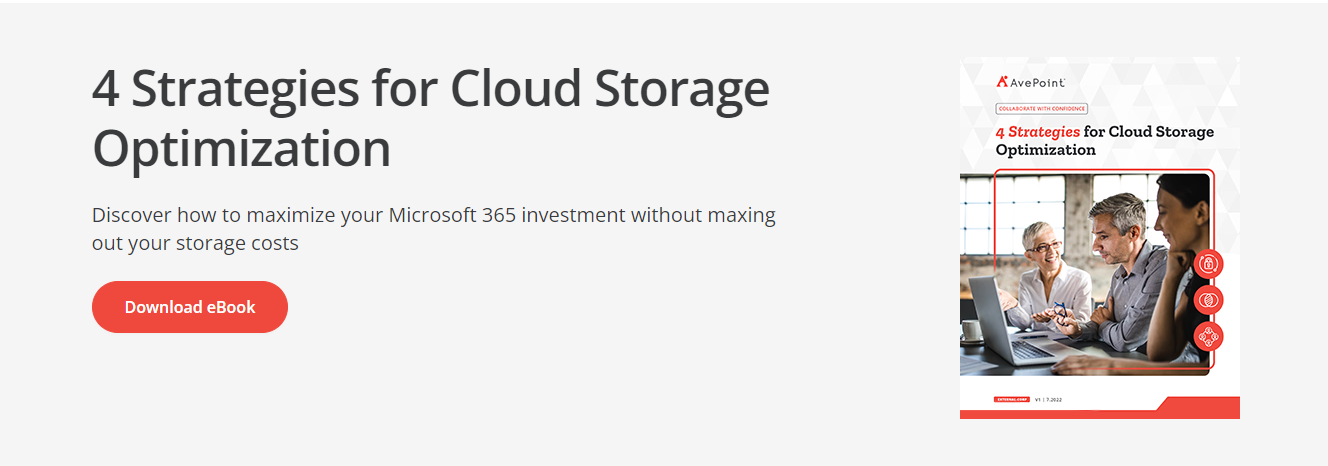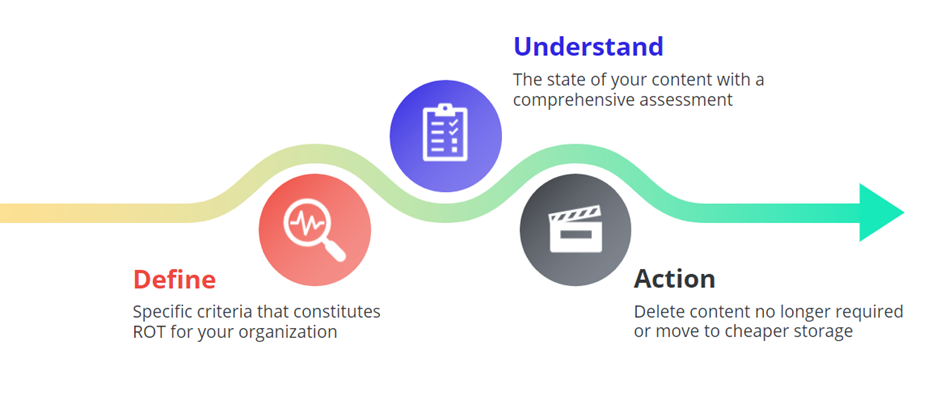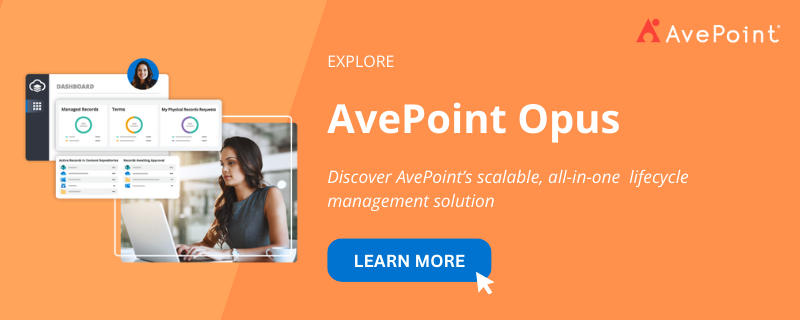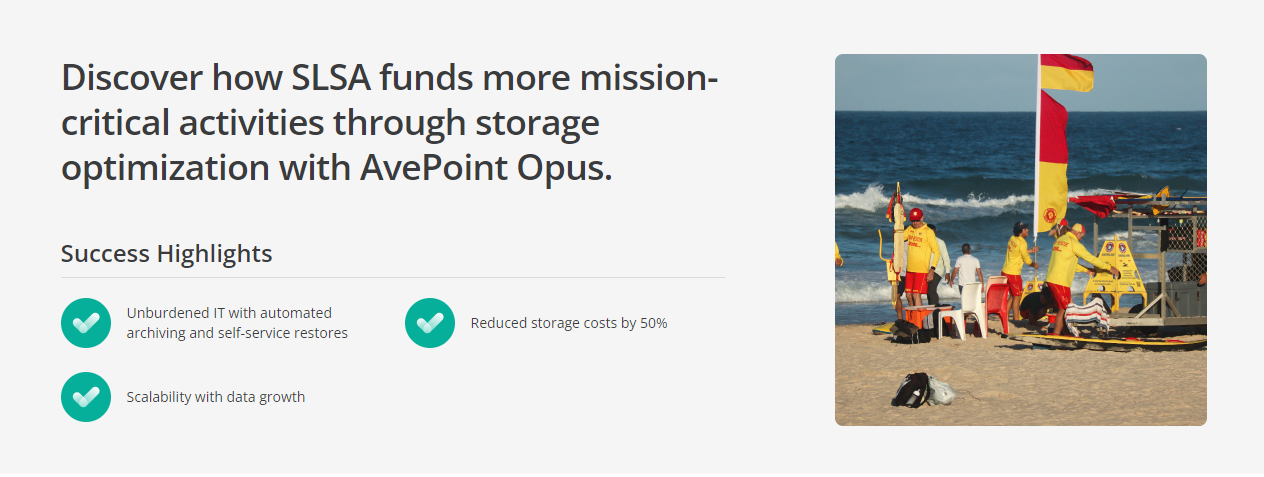How to Optimize Cloud Storage: A 3-Step Guide to Success

Data and information continue to grow at an unprecedented rate, driven by the rise of generative AI; collaboration tools like Microsoft Teams, OneDrive, and SharePoint; and remote work that relies on content creation for communication rather than traditional in-person activities. This pace of accelerated growth puts pressure on organizations to be agile and adapt quickly to new realities and challenges produced by the evolving digital landscape.
In the State of the Intelligent Information Management Industry report produced by AIIM, 78% of organizations feel flooded with the three V’s of big data — volume, velocity, and variety — resulting from different technology usage. And as the three V’s increase, so do the three U’s of dark data — unclassified, unused, and unknown.
According to Cybersecurity Ventures, the amount of data stored in the cloud alone is projected to exceed 200 zettabytes by 2025. While much of this data tends to be neglected or forgotten, organizations cannot ignore the fact that it occupies space, increases operational costs, and poses unacceptable risks. How can organizations successfully optimize their cloud storage?
The Case for Storage Optimization
As organizations continue collecting, processing, and storing data as part of regular business activities, disparate storage solutions and indiscriminate data hoarding have become major concerns. These result in an overwhelming amount of information that goes stale or is no longer relevant over time.
Here are some of the consequences of storing large amounts of data:
Overage Costs
Organizations recognize the cloud benefits in improving processes, increasing revenue, and reducing IT spend. However, they are still struggling to achieve their business goals.
The problem? According to IDC’s Q4 2022 Cloud Pulse Survey, 55% of cloud buyers say inflationary pressures negatively impacted return on investment (ROI). As the volume of stored data increases, so do the costs associated with not only managing and protecting it but also simply retaining it. In a 2021 report, more than one-third of businesses have cloud budget overruns of up to 40%.
Not all data is important, and it is critical to find and weed out unnecessary data to reduce the amount of content you store. Do not let your organization spend millions on wasted storage of unused data.
Learn more about the value of storage optimization to save budgets, reduce risks, and drive productivity. Download the 4 Strategies for Cloud Storage Optimization eBook.

Security Risks
It is not only storage costs that are on the rise but also the risks. According to Forrester’s Security Survey in 2023, 77% of security decision-makers experienced at least one data breach at their firm over the past 12 months. Hoarding data compounds this risk – the more data you store, the larger your attack surface becomes.
At the current rate, an expanding data attack surface means it only takes one unsecured device or malicious app to potentially compromise an entire corporate network and the data stored within. The lack of end-to-end visibility into where your data resides and its contents further exacerbates this risk. For example, an employee might inadvertently copy sensitive information on non-secure devices and expose them to security threats.
Besides any reputational damage, your organization may also have to pay a fine for exposing customer information related to the breach. Cybersecurity Ventures predicts that cybercrime will cost the world $8 trillion in 2023 and $10.5 trillion by 2025, growing at a rate of 15% per year.
Management Challenges
You may think that having more information means more ability to generate valuable insights into business challenges and opportunities. However, a recent Gartner survey reveals that 47% of digital workers struggle to find the information needed to perform their jobs effectively.
This is supported by an IDC report stating data workers spend 90% of their working week (around 36 hours) on data-related activities such as searching, preparing, and managing rather than focusing directly on analytics, where the true value lies.
With the data explosion showing no signs of slowing down, organizations are also suffering from inefficiencies and ineffectiveness. The cloud may give you unlimited storage, but it can also produce unlimited chaos if not controlled at the organizational level.
How will storage optimization help? The answer is simple: organizations must reduce the amount of data they have. This does not mean simply deleting swathes of data; instead, organizations need to optimize data storage to transform data to its full potential. However, it is not a one-size-fits-all strategy. Storage optimization must be catered to your own business in order to ensure you continue to meet compliance and regulatory requirements and do not disrupt regular business operations. Otherwise, many of the consequences of too much data may soon become the consequences of not enough.
3 Steps Guide for a Successful Storage Optimization
The best way to deal with dark data is to find ways to control, manage, and reduce the amount of unknown, unclassified data in your ecosystem. Here are three steps to guide your storage optimization journey:

1. Define
Organizations are drowning in data, mainly due to fear that a piece of data today might suddenly become important five to 10 years from now and believing that the worst thing you can do is delete any data.
A practical first step is to establish clear criteria that defines redundant, obsolete, and trivial (ROT) data for your organization, ensuring alignment with business goals and compliance requirements. This allows you to build a foundation for an intelligent storage optimization strategy.
For instance, if you possess 10 terabytes of data that is over seven years old, deleting it may seem a straightforward decision. However, it is not that simple. You also need to consider the need to hold onto content for regulatory or business requirements as well as considering usage and access to that content from users across the organization. If there are documents that have not been accessed in three years, tagging them for archiving could be a course of action should they be required at a later date. This means that you are not using the most expensive storage for things that are not being accessed, but they are still retained for the correct period of time. Conversely, if specific files are accessed daily, flagging them as critical to prevent inadvertent deletion or archiving during this process would be advisable.
AvePoint Opus simplifies the process of defining your scope. Leverage built-in rules to guide you if you are unsure where to start or if you have questions about best practices from other organizations. You can also customize these rules to suit your specific needs, including whether to consider data versions. With a variety of out-of-the-box definitions and the ability to create your own rules, AvePoint Opus provides a flexible framework to manage your data effectively.
2. Understand
Once you have clearly defined your scope, conduct a comprehensive assessment across your data types, storage locations, and data structuring to understand the state of your data landscape. When you clearly understand the data you are storing, you can make more informed decisions regarding its management. Setting up periodic data reviews and audits is crucial for maintaining storage efficiency and freeing up space to improve system performance.
The AvePoint Opus Discovery & Analysis tool scans your environment and synthesizes the findings into a summary report. The report can break down the state of your data in great detail, such as by data size, version size, overall file count, and data by file type. Then, you will have a detailed understanding of your inactive data size and what type of file format might be triggering the overage.

3. Take Action
It is not enough to identify areas for opportunity; you need to act on the information you learned. This does not necessarily mean you need to delete everything, but rather, take a managed and measured approach to ensure information is being retained or destroyed in the most appropriate way. Organizations can implement tiered storage solutions that archive data before eventual deletion, allocating the most efficient and cost-effective storage resources according to the importance and sensitivity of the data.
AvePoint Opus does more than assess your data; it empowers you to take immediate, impactful action on those insights. This leads to cost savings, maintains data integrity, and enhances team efficiency. With the Discovery & Analysis tool, you can archive data to more cost-effective storage or remove unnecessary files. Information is one of an organization’s greatest assets, and when managed poorly, it can lead to financial losses and hinder productivity. By optimizing your data, AvePoint Opus enables you to make better decisions, benefiting your organization and, ultimately, your customers. This is more than just data management — it is about empowering you to thrive.
Customer Story
Surf Life Saving’s growing IT budget and storage costs were threatening to impact its mission-critical activities. With AvePoint Opus, SLSA reduced their storage costs by 50%.
“Every dollar that is spent on IT are dollars that can’t go back to the clubs and rescue efforts. It could mean the difference in a club having a rescue boat or extra jet rescue when they need it. With these solutions, we are successfully reducing IT budget and putting more money to saving lives.” Scott Randall. Manager - National ICT Unit, SLSA
Read Surf Life Saving's success story here:

What’s Next?
Optimizing your storage is just one piece of the puzzle in making better business decisions. To truly thrive, you need a comprehensive information management strategy and a robust platform to support it. Enter AvePoint Opus — not only an archiving solution but also a powerful information management platform. With Opus, you can establish and automate business rules for classification, archiving, and more, ensuring that every stage of your content lifecycle is meticulously managed from creation to deletion. This holistic approach guarantees that your admins can effortlessly stay in control without any extra burden, regardless of how much data your organization generates. Embrace the future of data management with AvePoint Opus and empower your organization to operate at its full potential.
Ready to level up your storage optimization game? Watch our webinar: How to Outrun Rising M365 Storage Costs

Amabel Palencia is a Content Marketing Specialist at AvePoint, covering channel marketing and partner programs, information lifecycle management, artificial intelligence (AI) readiness, data management, and cloud storage optimization. A journalism graduate, she has 15+ years of experience in project management, customer engagement, communications, and content marketing strategy for B2B campaigns. She creates content that helps MSPs and other partners navigate the rapidly changing digital landscape.



